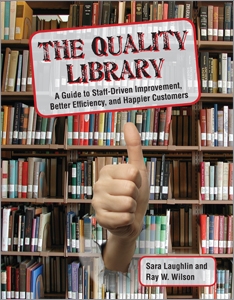Primary tabs
You don't need to be an ALA Member to purchase from the ALA Store, but you'll be asked to create an online account/profile during the checkout to proceed. This Web Account is for both Members and non-Members.
If you are Tax-Exempt, please verify that your account is currently set up as exempt before placing your order, as our new fulfillment center will need current documentation. Learn how to verify here.
- Description
- Table of Contents
- About the authors
- Reviews
In an environment of budget cuts and freezes, libraries must keep a tight rein on costs and inefficiencies. The efficiency of systems and processes goes hand-in-hand with excellent customer service. Managers, however, often find themselves far enough removed from the day-to-day activities in the library that they don't know where inefficiencies, mistakes, and poor customer service may occur.
Based on more than 50 years of author expertise in organizational improvement, The Quality Library offers a methodology to pinpoint trouble areas and improve processes. By developing a customer-focused system outlining library processes and networks, administrators and managers can quickly determine areas for improvement that directly apply to the library's goals and missions. Staff will also learn how to statistically document the new process's performance, giving the library a means to quantify its effects.
- Gives administrators a clear understanding of their suppliers and customers
- Empowers front-line staff to make improvements and better decisions
- Boosts employee and team morale as they work together to bring about change
- Offers real-life success examples showing how process improvement works
- Includes figures, appendices, worksheets, and a glossary
By continuously evaluating processes based on the guidelines and worksheets provided here, public and academic library administrators and managers will improve the quality and efficiency of service for patrons and staff alike.
Foreword
Preface
Acknowledgments
Introduction
Chapter 1 The Continuous Improvement Approach
Chapter 2 Identify Library Processes and Assess Their Importance and Condition
Chapter 3 Standardize the Process
Chapter 4 Measure Process Performance
Chapter 5 Rapidly Improve the Process
Chapter 6 Manage Process Improvement throughout the Library System
Appendix A List of Library Processes
Appendix B Library Process Measures
Glossary of Process Improvement Terms
References
Index
Sara Laughlin
Sara Laughlin is president of Sara Laughlin & Associates, a consulting firm specializing in customer-focused, future-oriented planning, evaluation, and continuous improvement. In her 30-plus years as a librarian, she has worked as a reference librarian, branch manager, consortium director, library school faculty, and as a library trustee. Her consulting clients include public and academic libraries, school districts, State librarians and regional consortia, as well as foundations and other non-profits.
Ray Wilson
Ray Wilson is a process engineer with 25+ years experience. He is the author of Process Mastering; How To Establish and Document the Best Known Way To Do a Job (Quality Resources, 1998). Ray and Sara have worked together over the last four years in the Indiana Staff Development Council. He is also an active member of the Indy Quality, Productivity, and Improvement Council. Ray has contributed his knowledge and experience with process improvement, as well as tools and techniques, to the Continuous Improvement Initiative.
"Recommended to all library administrators and managers seeking ways to improve internal operations and services."
--Theological Librarianship
"...gives clear direction on how to escape the trap of inefficient and/ or ineffective processes and replace them with policies and workflows that enhance the library user's experience and better address user expectations."
--Serials Review
"The book deserves a wide readership and I recommend it to all libraries, great, and small.
--The Electronic Library
"The volume itself is laid out in a very easy to follow, step-by-step arrangement. It is full of flow charts, graphs, and worksheets that are intended to help layout the framework for implementation at your library. The appendices are especially useful to those interested in examining their libraries' work flows."
--Internet Reference Services Quarterly



